
Introduction
The introduction is the opening section of a written piece, usually a blog post, article, or essay. Its purpose is to capture the reader’s attention, provide a brief overview of the topic, and present the thesis or main argument of the piece. In the case of a blog post on how developers can survive an AI invasion, the introduction should define what is meant by AI invasion and why it is important for developers to be prepared for it. It should set the stage for the discussion that follows, highlighting the potential dangers of AI and how developers can navigate them to remain relevant in a world increasingly dominated by intelligent machines.
Understanding AI
Artificial Intelligence (AI) is the ability of machines or computer systems to perform tasks that would otherwise require human intelligence. AI has been rapidly advancing in recent years and has the potential to transform many areas of society, including healthcare, transportation, and finance. Here are the key aspects of understanding AI:
Types of AI systems:
AI can be classified into three categories: Narrow or Weak AI, General AI, and Super AI. Narrow AI is designed to perform a specific task, such as image recognition or natural language processing. General AI is a system that can perform any intellectual task that a human can, while Super AI is hypothetical AI that surpasses human intelligence and has the ability to learn and improve itself.
How AI works:
AI is based on algorithms that allow machines to learn from data. This is done through machine learning, where the system is trained on a large dataset and learns to recognize patterns and make predictions. Deep learning is a subset of machine learning that uses neural networks to simulate the structure and function of the human brain.
Applications of AI:
AI has many applications across industries, including healthcare, finance, transportation, and manufacturing. In healthcare, AI is used for medical imaging, drug discovery, and personalized medicine. In finance, AI is used for fraud detection, risk management, and trading. In transportation, AI is used for self-driving cars and traffic optimization. In manufacturing, AI is used for quality control and predictive maintenance.
Challenges of AI:
AI poses several challenges, including job displacement, security and privacy risks, and unintended consequences. As machines become more intelligent, they may replace human workers in certain tasks, leading to job loss and economic disruption. AI systems can also be vulnerable to cyberattacks, leading to security breaches and privacy violations. Finally, AI systems can have unintended consequences, such as algorithmic bias or unexpected behaviors.
understanding AI is critical for developers and anyone working with technology. By staying up-to-date with the latest advancements and challenges in AI, developers can create ethical and effective solutions that enhance human lives and protect against potential dangers.
The potential dangers of AI invasion for developers
As AI becomes increasingly advanced and prevalent, there are several potential dangers that developers need to be aware of. Here are some of the key dangers of AI invasion that developers should keep in mind:
Job displacement:
One of the most significant dangers of AI invasion is the potential for job displacement. As AI systems become more sophisticated, they may be able to perform tasks that were previously done by humans, leading to job loss and economic disruption. Developers need to be aware of this potential impact and work to create AI solutions that augment human workers rather than replace them.
Security and privacy risks:
AI systems can also pose security and privacy risks. As these systems become more connected and integrated into our daily lives, they may be vulnerable to cyberattacks, which could compromise sensitive data or even put lives at risk. Developers need to prioritize security and privacy in their AI solutions, implementing robust measures to protect against cyber threats.
Unintended consequences:
Another danger of AI invasion is the potential for unintended consequences. AI systems can be complex and difficult to understand, and their behavior can sometimes be unpredictable. For example, an AI system trained to optimize traffic flow might inadvertently cause congestion in certain areas due to unexpected interactions with other systems or unforeseen changes in traffic patterns. Developers need to be aware of these risks and take steps to mitigate them.
Algorithmic bias:
AI systems can also be subject to algorithmic bias, which occurs when the system produces biased outcomes due to incomplete or biased data. For example, an AI system used in hiring may discriminate against certain groups of people based on biased training data. Web Developers in Dindigul need to be aware of this potential risk and take steps to ensure their AI systems are fair and unbiased.
the potential dangers of AI invasion for developers include job displacement, security and privacy risks, unintended consequences, and algorithmic bias. By being aware of these risks and prioritizing ethical and responsible AI development, developers can create AI solutions that benefit society while minimizing potential harm.
How developers can survive AI invasion
As AI becomes more advanced and prevalent, developers need to adapt in order to survive and remain relevant. Here are some key strategies that developers can use to survive AI invasion:
Embrace new technologies:
Developers need to stay up-to-date with the latest AI technologies and tools in order to remain competitive. This means being willing to learn new programming languages, frameworks, and algorithms that are relevant to AI. Developers can also attend conferences, workshops, and online courses to stay current with the latest developments in AI.
Focus on creativity and innovation:
While AI systems can perform many tasks, they still lack the creativity and innovation of human developers. By focusing on these skills, developers can create new and innovative solutions that are not easily replicated by AI. This means being willing to take risks, think outside the box, and experiment with new ideas.
Develop specialized skills:
Developers can also differentiate themselves by developing specialized skills in areas that are not easily replicated by AI. This might include skills in user experience design, project management, or data analysis. By becoming experts in these areas, developers can position themselves as valuable members of AI development teams.
Collaborate with AI systems:
Rather than seeing AI as a threat, developers can collaborate with AI systems to create new and innovative solutions. This means understanding the strengths and limitations of AI systems and using them to augment human capabilities rather than replace them. Developers can also work to create ethical and responsible AI systems that benefit society.
Emphasize soft skills:
In addition to technical skills, developers need to have strong communication, collaboration, and problem-solving skills in order to work effectively with AI systems and other team members. By emphasizing these soft skills, developers can demonstrate their value as team players and leaders in AI development projects.
developers can survive AI invasion by embracing new technologies, focusing on creativity and innovation, developing specialized skills, collaborating with AI systems, and emphasizing soft skills. By staying adaptable and continually learning, developers can remain relevant in a world increasingly dominated by AI.
What are the AI Tools that are dangerous for Website Developer
There are several AI tools that can be potentially dangerous for website developers in Dindigul if used improperly. Here are some examples:
Web Scrapers:
Web scraping is a technique that uses AI to extract data from websites automatically. While it has legitimate uses, such as gathering data for market research, it can also be used for malicious purposes, such as stealing sensitive information or intellectual property.
Content Generators:
AI content generators are programs that can automatically generate articles, blog posts, and other written content. While they can save time and effort, they can also produce low-quality content that can harm the reputation of a website.
SEO Tools:
SEO tools use AI to optimize website content for search engine rankings. While they can be helpful, they can also be used to manipulate search results, such as by using black hat SEO techniques.
Automated Testing Tools:
Automated testing tools use AI to test websites and identify potential issues. While they can improve website quality and efficiency, they can also produce false positives or overlook important issues.
Chatbots:
Chatbots can be used on websites to simulate human conversations with users. While they can improve customer service and user experience, they can also be used for phishing attacks or to spread misinformation.
Conclusion
In conclusion, AI invasion presents both opportunities and challenges for developers. While AI technologies can automate many tasks and improve efficiency, they also raise concerns about job displacement and ethical considerations. Developers can survive AI invasion by embracing new technologies, developing specialized skills, collaborating with AI systems, and emphasizing soft skills. They must also be aware of the potential dangers of AI tools and work to ensure that they are used ethically and responsibly. By staying adaptable and continuously learning, developers can position themselves to thrive in a world increasingly dominated by AI.

